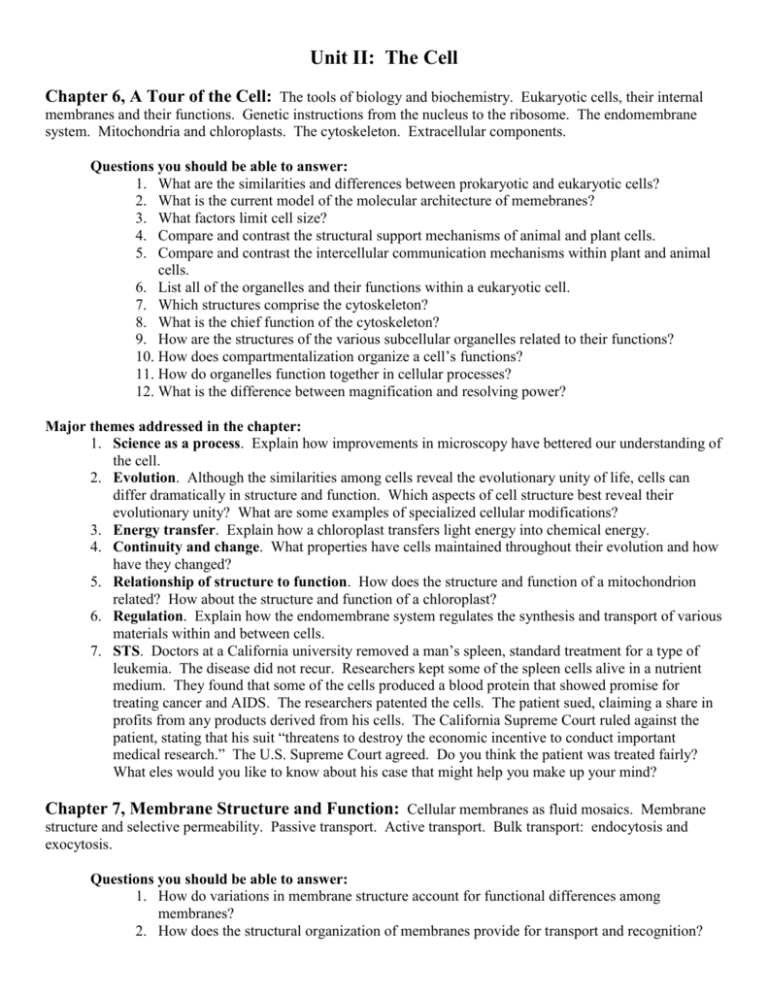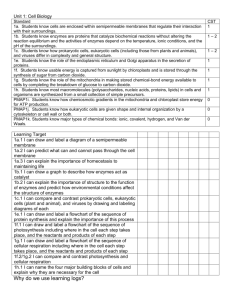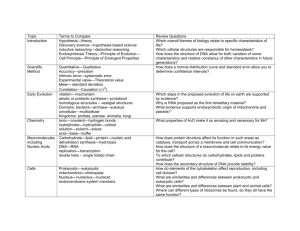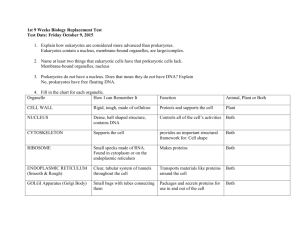AP Biology Unit 2
advertisement

Unit II: The Cell Chapter 6, A Tour of the Cell: The tools of biology and biochemistry. Eukaryotic cells, their internal membranes and their functions. Genetic instructions from the nucleus to the ribosome. The endomembrane system. Mitochondria and chloroplasts. The cytoskeleton. Extracellular components. Questions you should be able to answer: 1. What are the similarities and differences between prokaryotic and eukaryotic cells? 2. What is the current model of the molecular architecture of memebranes? 3. What factors limit cell size? 4. Compare and contrast the structural support mechanisms of animal and plant cells. 5. Compare and contrast the intercellular communication mechanisms within plant and animal cells. 6. List all of the organelles and their functions within a eukaryotic cell. 7. Which structures comprise the cytoskeleton? 8. What is the chief function of the cytoskeleton? 9. How are the structures of the various subcellular organelles related to their functions? 10. How does compartmentalization organize a cell’s functions? 11. How do organelles function together in cellular processes? 12. What is the difference between magnification and resolving power? Major themes addressed in the chapter: 1. Science as a process. Explain how improvements in microscopy have bettered our understanding of the cell. 2. Evolution. Although the similarities among cells reveal the evolutionary unity of life, cells can differ dramatically in structure and function. Which aspects of cell structure best reveal their evolutionary unity? What are some examples of specialized cellular modifications? 3. Energy transfer. Explain how a chloroplast transfers light energy into chemical energy. 4. Continuity and change. What properties have cells maintained throughout their evolution and how have they changed? 5. Relationship of structure to function. How does the structure and function of a mitochondrion related? How about the structure and function of a chloroplast? 6. Regulation. Explain how the endomembrane system regulates the synthesis and transport of various materials within and between cells. 7. STS. Doctors at a California university removed a man’s spleen, standard treatment for a type of leukemia. The disease did not recur. Researchers kept some of the spleen cells alive in a nutrient medium. They found that some of the cells produced a blood protein that showed promise for treating cancer and AIDS. The researchers patented the cells. The patient sued, claiming a share in profits from any products derived from his cells. The California Supreme Court ruled against the patient, stating that his suit “threatens to destroy the economic incentive to conduct important medical research.” The U.S. Supreme Court agreed. Do you think the patient was treated fairly? What eles would you like to know about his case that might help you make up your mind? Chapter 7, Membrane Structure and Function: Cellular membranes as fluid mosaics. Membrane structure and selective permeability. Passive transport. Active transport. Bulk transport: endocytosis and exocytosis. Questions you should be able to answer: 1. How do variations in membrane structure account for functional differences among membranes? 2. How does the structural organization of membranes provide for transport and recognition? 3. What are the various mechanisms by which substances cross membranes? 4. Explain and give an example of how the control of the flow of molecules across the membrane maintains a favorable intracellular environment. 5. Explain what is meant by the term “phospholipid bilayer.” 6. Compare and contrast active and passive transport. 7. What is osmosis? How does it work? 8. Explain cotransport. How does it benefit the cell? Major themes addressed in the chapter: 1. Science as a process. How have the various models of the cellular membranes contributed to our current understanding of the plasma membrane? 2. Evolution. Paramecium and other protests that live in hypotonic environments have cell membrane adaptations that slow osmotic water uptake, while those living in isotonic environments have more permeable cell membranes. What water regulation adaptations would you expect to have evolved in protests living in hypertonic habitats such as Great Salt Lake? How about those living in habitats where salt concentration fluctuates? 3. Energy transfer. How does the cell use energy to drive the uptake of certain molecules into the cell? (Active transport and cotransport.) 4. Relationship of structure to function. How is the structure of the plasma membrane related to its function? 5. Regulation. Explain how a cell uses its ion pumps to regulate its membrane potential. 6. STS. Extensive irrigation in arid regions causes salts to accumulate in the soil. (The water contains low concentration of salts, but when the water evaporates from the fields, the salts are left behind to concentrate in the soil.) Based on what you have learned about water balance in plant cell, explain why increasing soil salinity has an adverse effect on agriculture. Suggest some ways to minimize this damage. What costs are attached to you solutions. Chapter 8, An Introduction to Metabolism: Energy transformation and the laws of thermodynamics. Free energy change. ATP power and the coupling of exergonic reactions to endergonic reactions. Activation energy and enzymes. Regulation of enzymes and the control of metabolism. Questions you should be able to answer: 1. How do the laws of thermodynamics relate to the biochemical processes that provide energy to living systems? 2. How do enzymes regulate the rate of chemical reactions? 3. How does the specificity of an enzyme depend on its structure? 4. How is the activity of an enzyme regulated? 5. What is the role of ATP in coupling the cell’s anabolic and catabolic processes? 6. A cell must spend energy to transcribe and translate a gene because entropy decreases as monomers are organized into complex macromolecules. Explain. 7. Regulator molecules in the cell interact with some enzymes and control their activity by changing the shape of the enzymes. Explain and give an example. 8. What is the difference between enthalpy and entropy? Major themes addressed in the chapter: 1. Evolution. A recent revival of the anti-evolutionary “argument for intelligent design” holds that biochemical pathways are too complex to have evolved, because all intermediate steps in a given pathway must be present to produce the final produce. Critique this argument. How could you use the existing diversity of metabolic pathways that produce the same or similar products to support your case? 2. Energy transfer. What role do enzymes play when reactants are converted to products in a chemical reaction? 3. Relationship of structure to function. How is an enzymes structure related to its function. 4. Regulation. How does the regulation of enzyme activity help control metabolism? 5. Interdependence in nature. Explain how an organisms metabolism is subject to the laws of thermodynamics. 6. STS. The EPA is evaluating the safety of the most commonly used organophosphate insecticides (organic compounds containing phosphate groups). Organophosphates typically interfere with nerve transmission by inhibiting the enzymes that degrade the transmitter molecules diffusing from one neuron to another. Noxious insects are not uniquely susceptible; humans and other vertebrates can be affected as well. Thus, the use of organophosphates pesticides creates some health risks. As a consumer, what level of risk are you willing to accept in exchange for an abundant and affordable food supply? What other facts would you like to know before you defend your opinion? Chapter 9, Cellular Respiration—Harvesting Chemical Energy: Catabolic pathways. Glycolysis. Citric acid cycle. Oxidative phosphorylation and chemiosmosis. Fermentation. Glycolysis. Questions you should be able to answer: 1. How does chemiosmosis function in bioenergetics? 2. How are organic molecules broken down by catabolic pathways? 3. What is the role of oxygen in energy-yielding pathways? 4. How do cells generate ATP in the absence of oxygen? 5. Distinguish between substrate-level phosphorylation and oxidative phosphorylation. 6. Summarize the steps of glycolysis and describe where it occurs in the cell. 7. Why is the Krebs Cycle a “cycle?” 8. Summarize the steps of the Krebs Cycle and describe where it occurs in the cell. 9. Describe the process of chemiosmosis. 10. Describe the link between glycolysis and cellular respiration. 11. Describe the fate of pyruvate in the absence of oxygen. 12. Describe the difference between aerobic and anaerobic respiration. 13. Explain how ATP production is controlled by the cell. What role does the allosteric enzyme phosphofructokinase play in the process? 14. The membranous organization of the mitochondrion orders the process of cellular respiration. Explain. Major themes addressed in the chapter: 1. Evolution. ATP synthase enzymes are found in the prokaryotic plasma membrane and in mitochondria and chloroplasts. What does this suggest about the evolutionary relationship of these eukaryotic organelles to prokaryotes? How might the amino acid sequences of the ATP syntheases from the different sources support or refute you hypothesis? 2. Energy transfer. Explain how energy is transferred through glycolysis, the citric acid cycle, and oxidative phosphorylation. 3. Relationship of structure to function. How is the structure of a mitochondrion related to its function? 4. STS. Trematol is a metabolic poison produced by white snakeroot. Cows that stray from pastures into wooded areas sometimes ingest white snakeroot, a common inhabitant of North American forests. Trematol becomes concentrated in the mild of these cows and may poison humans who drink the mild. In the early 1800’s, “milk sickness” killed thousands of settlers in the U.S. Midwest, including Abraham Lincoln’s mother when the future president was only 7 years old. Mild sickness is very rare today because white snakeroot is removed from grazing areas, and commercial dairies mix the milk of many cows, a practice that dilutes any toxins present in one or a few cows. The biochemical basis of the disease is now understood: Trematol inhibits an enzyme that helps convert lactate to other compounds in the liver. Why does physical exertion intensify the symptoms of milk sickness? Why does the pH of blood decrease in a person afflicted with milk disease? Chapter 10, Photosynthesis: Photosynthesis. Light reactions. Calvin cycle. C4 and CAM plants. Questions you should be able to answer: 1. How does photosynthesis convert light energy into chemical energy? 2. How are the chemical products of the light-trapping reactions coupled to the synthesis of carbohydrates? 3. What kinds of photosynthetic adaptations have evolved in response to different environmental conditions? 4. What interactions exist between photosynthesis and cellular respiration? 5. A proton gradient (chemiosmosis) across membranes powers the synthesis of ATP in mitochondria, chloroplasts, and prokaryotes. Explain. 6. Write a summary equation of photosynthesis. 7. Explain the role of REDOX reactions in photosynthesis. 8. Trace the electron flow through photosystems II and I 9. Compare cyclic and noncyclic electron flow and explain the relationship between these components of the light reactions. 10. Summarize the light reactions and explain where they occur. 11. Describe important differences in chemiosmosis between oxidative phosphorylation in mitochondria and photophosphorylation in chloroplasts. 12. Describe the role of ATP and NADPH in the Calvin cycle. 13. Describe what happens to rubisco when the O2 concentration is much higher than CO2. 14. Which photosystem generates O2? Why does it do this? 15. What simple experiment with chloroplasts supports the chemiosmotic model? 16. How are the Calvin cycle and the citric acid cycle similar? How are they different? Major themes addressed in the chapter: 1. Science as a process. How did Melvin Calvin and his students discover the sugar producing cycle of photosynthesis? 2. Evolution. C4 and CAM plants represent structural and biochemical adaptations for photosynthesis in hot and dry climates. Explain. 3. Energy transfer. Explain how plants transform light energy into chemical energy. 4. Relationship of structure to function. Explain how the chloroplast structure is related to its function. 5. Interdependence in nature. Describe the interdependence in nature between photosynthesis and cell respiration. 6. STS. CO2 in the atmosphere traps heat and warms the air, just as clear glass does in a greenhouse. Scientific evidence indicates that the CO2 added to the air by the burning of wood and fossil fuels is contributing to a rise in global temperature. Tropical rain forests are estimated to be responsible for more than 20% of global photosynthesis. It seems reasonable to expect that the rain forests would reduce global warming by consuming large amounts of CO2, but many experts now think that rain forests make little or no net contribution to reduction of global warming. Why might this be? (Hint: What happens to the food produced by a rain forest tree when it is eaten by animals or the tree dies?) Chapter 12, The Cell Cycle: Cell division. Mitosis and interphase. Cell cycle regulation. Questions you should be able to answer: 1. How does the cell cycle assure genetic continuity? 2. 3. 4. 5. 6. 7. 8. How does mitosis allow for the even distribution of genetic information to new cells? What are the mechanisms of cytokinesis? How is the cell cycle regulated? How can aberrations in the cell cycle lead to tumor formation? Ideally, the cell cycle clones a cell’s DNA. Explain. Describe the process of binary fission in prokaryotes. List the phases of the cell cycle and describe the sequence of events that occurs during each phase. 9. Describe the major events that occur during the G1, S and G2 periods of interphase. 10. List the phases of mitosis and describe the major events characteristic of each phase. 11. Explain the three ways in which cells divide. Major themes addressed in the chapter: 1. Evolution. How can errors in cell division result in genetic diversity? 2. Continuity and change. How does the cell cycle result in continuity within an organism and that organisms species? How does it result in change? 3. Relationship of structure to function. How are the structures within a cell related to their function in cell division? 4. Regulation. How is the cell cycle regulated? 5. STS. Cancer results from alterations of the cell cycle. Hundreds of millions of dollars are spent each year in the search for effective treatments for cancer; far less money is spent preventing cancer. Why do you think this is true? What kinds of lifestyle changes could we make to help prevent cancer? What kinds of prevention programs could be initiated or strengthened to encourage these changes? What factors might impede such changes and programs?








